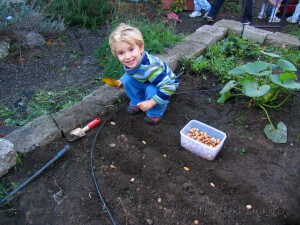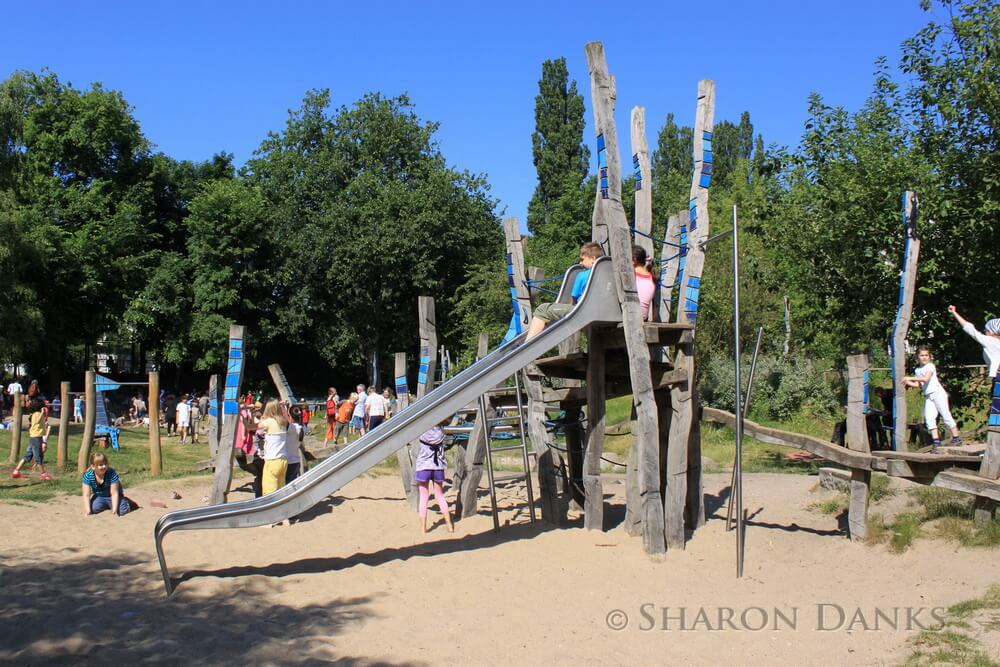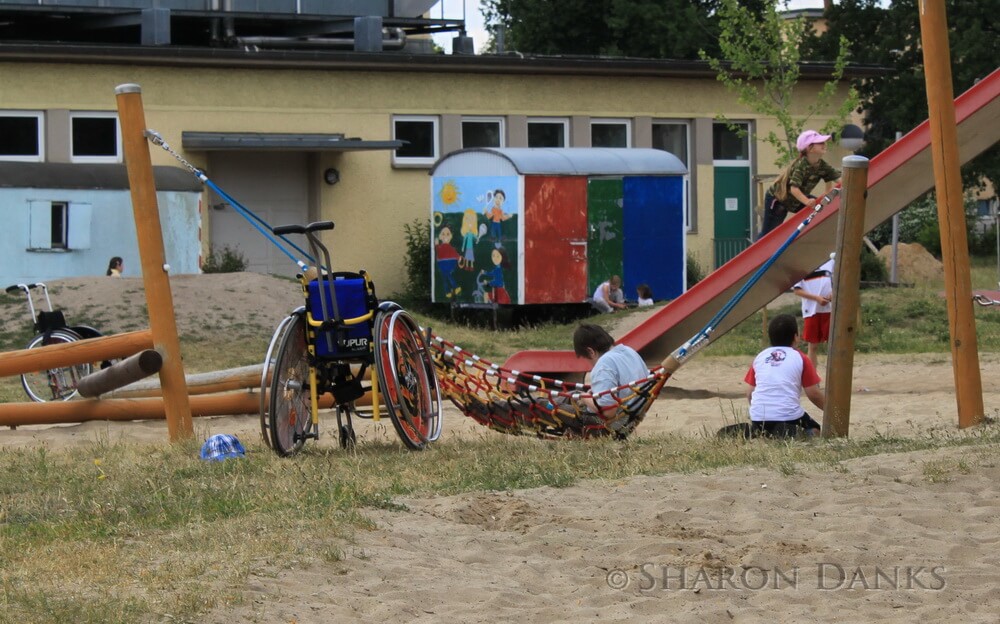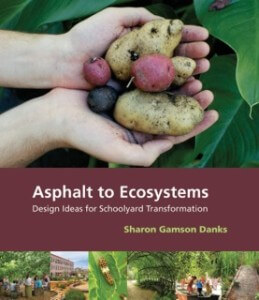THE GREEN SCHOOLYARD MOVEMENT: Gaining Momentum Around the World
First of two articles. Click here for part two.
C&NN supports getting children outside and moving. That can take place in various environments: green schoolyards and gardens; traditional playgrounds, play structures and playing fields; private yards and wild places. No one size fits all. Incorporating natural elements into new or existing play spaces can give an extra boost to children’s physical health, psychological well-being, and their ability to learn. In the first of two articles, environmental planner Sharon Gamson Dank shares her views on how to do that. — Richard Louv
 When you think about typical schoolyards, what image first comes to mind? For many people, school grounds are places covered by paved surfaces and manicured sports fields, adorned with a few, simple shrubs and trees, and one or two ordinary climbing structures.
When you think about typical schoolyards, what image first comes to mind? For many people, school grounds are places covered by paved surfaces and manicured sports fields, adorned with a few, simple shrubs and trees, and one or two ordinary climbing structures.
Most school grounds look the same, with very little variation to reflect unique aspects of each school community, the neighborhood’s ecological or geographic context, or teachers’ preferred curricula.
Children are masters at reading what Wendy Titman calls the “hidden curriculum” of school grounds, and understand the value adults place on them through the level of care given to their surroundings.
The messages most traditional schoolyards send children about their place in the world is not reassuring—particularly in our cities where many school sites are filled with asphalt and are home to very few living things.
Outside of school, spaces children can explore on their own have been shrinking over the last few generations, reducing children’s domain from miles of free ranging territory to the limited zone between home and the end of the block. Schoolyards are now one of the only places many children are allowed to play outdoors on a daily basis, and they are increasingly important for fostering children’s health and development. With this in mind, I believe that schools have a responsibility to provide the next generation with outdoor experiences that help them develop their curiosity, their sense of adventure, a healthy lifestyle, and a love of nature.

A green schoolyard movement is gaining momentum around the globe and has the potential to improve the lives of every child, every day.
Schools are reshaping their traditional yards, designed for 1940s educational methods, and creating beautiful, ecologically diverse landscapes with an eye toward the future. Schoolyard greening creates rich environments that connect nature and environmental sustainability with place-based learning, hands-on curricula, and imaginative play, while building community.
I have been lucky enough to have the opportunity to travel around the world over the last twelve years to see this vibrant movement in action and meet many people making a difference in their neighborhoods and cities from Tokyo to San Francisco, Toronto to Berlin, and beyond. Together, we formed an organization called the International School Grounds Alliance, and we are working to enrich children’s learning and play environments by improving the way school grounds are designed and used. The movement is growing and we invite you to join us in this important work.

Commercial play structures can be successfully interwoven with nature-based green schoolyards through thoughtful selection of materials, design and layout. Using natural fall zone materials, like sand, softens the feel of the playground, allows rainwater to soak into the ground, and provides additional interest for children’s creative play.
- Green schoolyards provide opportunities for students to tune in to their surroundings and get hands-on experience with nearby nature while gaining a better understanding of their own neighborhoods. They help children mark the seasons with changes in wildlife migrations, colorful leaves in autumn, and the length of shadows on the ground. They bring watershed education to life, as classes step outside when it rains to watch the rain flow off their school building, through a downspout, and out into the school’s rain garden or cistern. Many excellent, low-cost educational resources sit right outside the classroom doors, waiting to be tapped.
- Green schoolyards foster children’s social, physical, and intellectual growth by providing settings for imagination, exploration, adventure, and wonder, and dynamic environments in which to run, hop, skip, jump, twirl, eat and play in active, challenging, and creative ways. Enriched school grounds provide child-driven, play-based solutions to the obesity epidemic, and can promote healthier lifestyles through increased physical activity and nutrition-oriented gardening and cooking programs.
- Green schoolyards address important environmental issues in ways that even young children can participate in and understand. There are often site-based environmental issues that students can identify themselves, and then become empowered to repair, enriching their own corner of the world with their ingenuity. While these individual actions may be small, together these projects can fundamentally improve the local environment and profoundly change the way that students understand their place the world. This is a very positive way to approach the field of environmental education, and an inspiring, optimistic counterpoint to widespread Ecophobia and Nature-Deficit Disorder.
- Green schoolyards teach ecological literacy, invigorate children’s bodies, open and inspire young minds, and knit our communities more closely together in the process. Successful green schoolyards are the product of many hands that harness the collaborative potential of their school communities. Like the barn raisings of previous generations, this cooperation among community members reinforces interdependence, local self-reliance, and a “sense of community” creating useful, beautiful places at very low cost. When parents, teachers and students work together to improve their school and grounds, they foster closer relationships that in turn support student achievement and wellbeing. This movement shifts the way our society views these important, shared public spaces, and supports school district land management efforts with the energy of community partners.

Green schoolyards provide a wide range of nature experiences and places for challenging, imaginative play for children of all abilities.
Well-designed green schoolyards model the ecologically-rich cities we would like to inhabit.
They do this at a smaller scale, and teach the next generation how to live more lightly on the Earth—shaping places where urbanization and nature coexist and natural systems are prominent and visible, for all to enjoy. They inspire students and their communities with organic food production, wildlife habitat, energy conservation and production, rainwater collection and management, sustainable design practices and creative artwork. By teaching students to explore their environment with their hands, hearts, and minds—whether they are climbing into a tree house or diving into the challenges of the surrounding world—green schoolyards help us to plant seeds that will blossom as children grow up and help to shape an ecologically literate society.
We are all important participants of the green schoolyard movement. You can help it reach its potential to touch children in every neighborhood—by starting with your own. Get a conversation going with your neighbors, the principal at your local school, and your school district administrators. Dream of the school environment you would like to see for our children, and then help to shape this reality at your local school. The schoolyards of tomorrow will be what you and your community make them.
-
Network News
Earth Day: Young leaders advocate for change
-
Feature
Nature photographer Dudley Edmondson has a vision for the representation of Black and Brown faces in the outdoors
-
Richard Louv
EARTH MONTH: You're part of the New Nature Movement if....
-
Voices
Placemaking: How to build kinship and inclusive park spaces for children with disabilities
-
Network News
Children & Nature Network founders release report on global factors influencing the children and nature movement



 Environmental planner Sharon Gamson Danks is author of “
Environmental planner Sharon Gamson Danks is author of “

